Bambara Groundnut (Vigna subterranea)
Anthony Assibi Mahama
Iowa State University, Ames, Iowa 50011
Corresponding author: aamahama@iastate.edu
OUTLINE
- Overview
- Etymology
- Origin, domestication, and geographic distribution
- Description
- Growth conditions
- Production and use
- Breeding and improvement
- Untapped potential
- References
- Chapter information
1. OVERVIEW
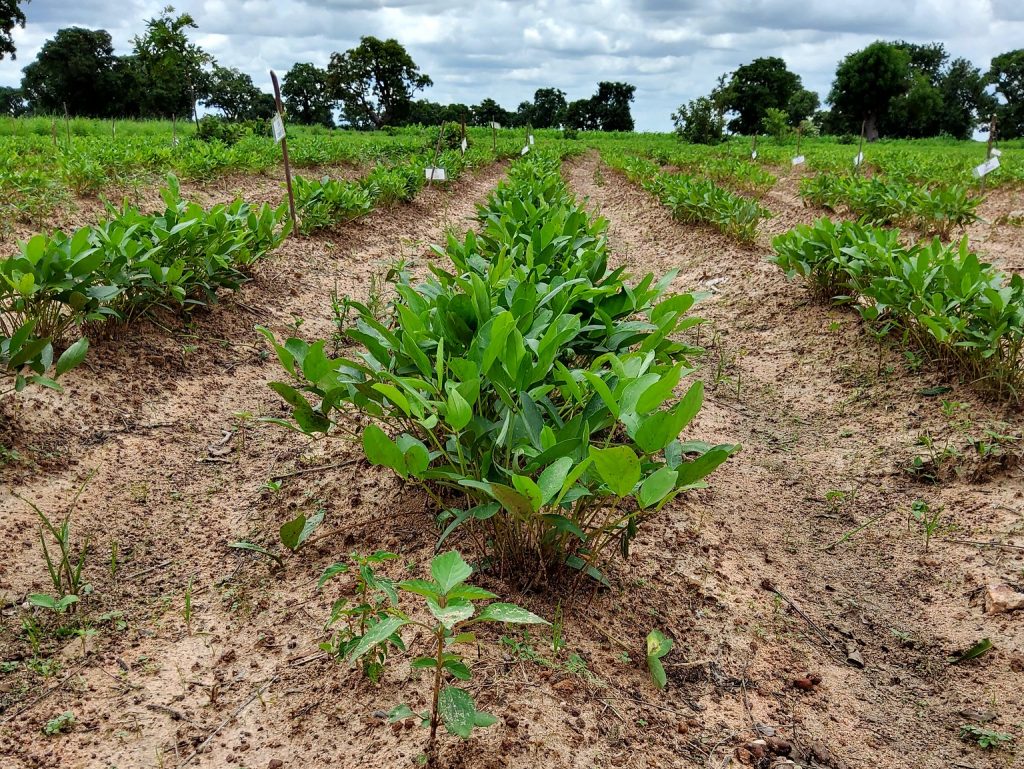
Bambara groundnut (BGN) or Bambara beans (Vigna subterranea (L.) Verdc.) is considered the third most important food legume crop in continental Africa after groundnut (Arachis hypogea) and cowpeas (Vigna unguiculata). It is recognized for its high nutritional value and as a complete crop (15–25% protein, 49–63.5% carbohydrate, 5.2–6.4% fiber, 4.5–7.4% fat, 3.2–4.4% ash, and 2% mineral) (Bamshaiye et al., 2011; Holm & Marloth, 1940; Jideani & Diedericks, 2014; Murevanhema & Jideani, 2013), as well as its tolerance to poor soils, drought, and salt stress, and its ability to produce in conditions where groundnuts/peanuts completely fail. These are possibly the main reasons for it still being maintained and grown by local populations (Adzawla et al., 2016a,b; Olayide et al., 2018). It has recently been declared one of the “crops of the new millennium” (Ahmad, 2012).
2. Etymology
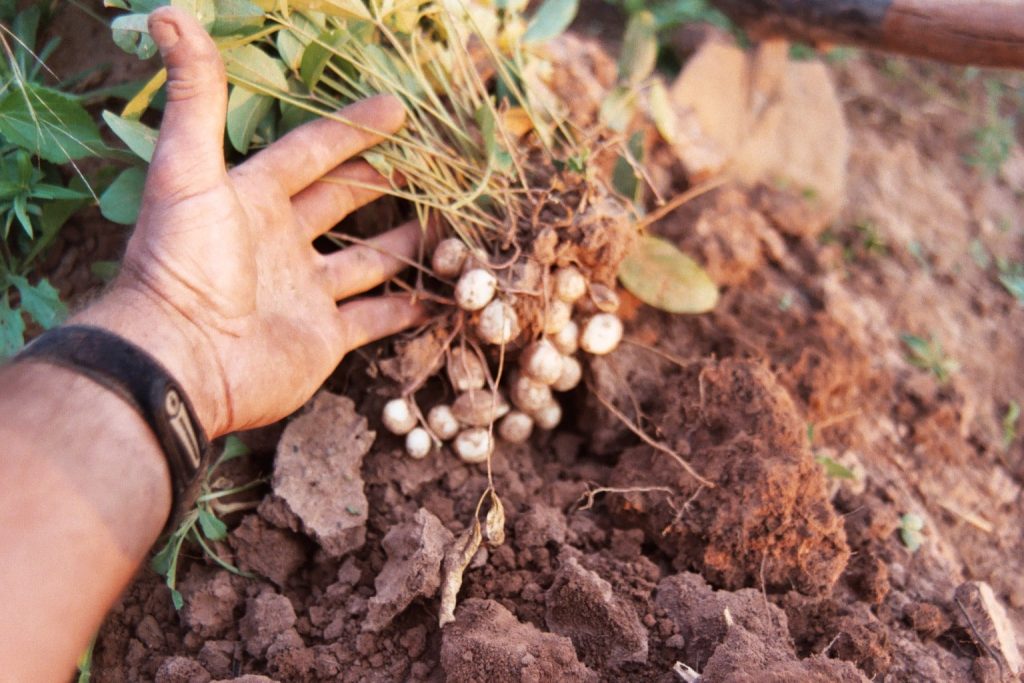
Bambara groundnut is an annual legume belonging to the family Leguminosae (Fabaceae), subfamily Papilionoideae (Faboidea), and the genus Vigna. It had a botanical name change from Voandzeia subterranea (L.) Thouars to Vigna subterranea (L.) Verdc., following a report by Verdcourt (1980). The Bambara groundnut originates from the continent of Africa and is generally cultivated in sub-Saharan Africa. The name Bambara originated from the Bambara district on the upper Niger (Hillocks et al, 2012). It goes by many different names in sub-Saharan Africa (SSA) according to the country where it is grown and even the tribe growing it. Some common names include Congo groundnut, Congo goober, Madagascar groundnut, earth pea, baffin pea, njugo bean (South Africa), voandzou (Togo), Nzama Jugo bean (Malawi), indhlubu (Zimbabwe), nyimo beans, or ditloo in Southern Africa, and underground bean. In Brazil, it is called mandubi d’Angol. Bambara groundnut has long been referred to as a “poor man’s” crop and most commonly as a “women’s” crop because it was grown and tendered mainly by women to achieve food security for the family (Ntundu et al, 2006).
3. ORIGIN, DOMESTICATION, AND GEOGRAPHIC DISTRIBUTION
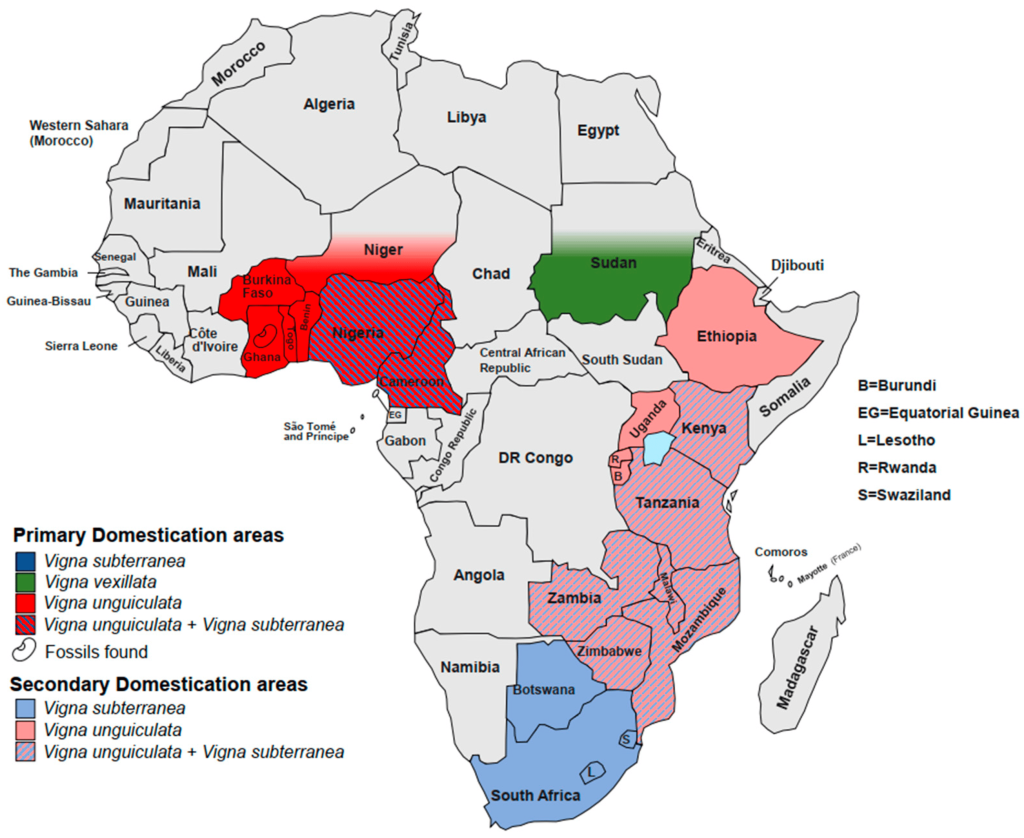
Studies suggest that Bambara groundnut originated from the continent of Africa (Hepper, 1970), specifically from Timbuktu areas in central Mali, West Africa (Hillocks et al., 2012). However, the primary center of genetic diversity of Bambara groundnut is the northeastern region of Nigeria and northern Cameroon (Dalziel, 1937; Hepper, 1963) from where it spread across sub-Saharan Africa. A secondary center of diversity exists outside Africa and includes Sri Lanka, Malaysia, the Philippines, and India (Rungnoi et al., 2012). It is cultivated extensively by small-scale farmers in the drier regions of sub-Saharan Africa under the traditionally low-input and marginal agricultural production systems (Pasipanodya et al., 2022). The crop currently is widely distributed and grown in tropical regions of America, northern Australia, and Asia (including India, Indonesia, Malaysia, Philippines, and Thailand) but the level of its cultivation is very low. While seldom grown in the United States, Bambara groundnut produces a nutritious food under cultivation throughout Africa. It was carried to America by slaves but has never become as popular as the peanut, which has a higher level of protein and is more robust in growth.
4. DESCRIPTION
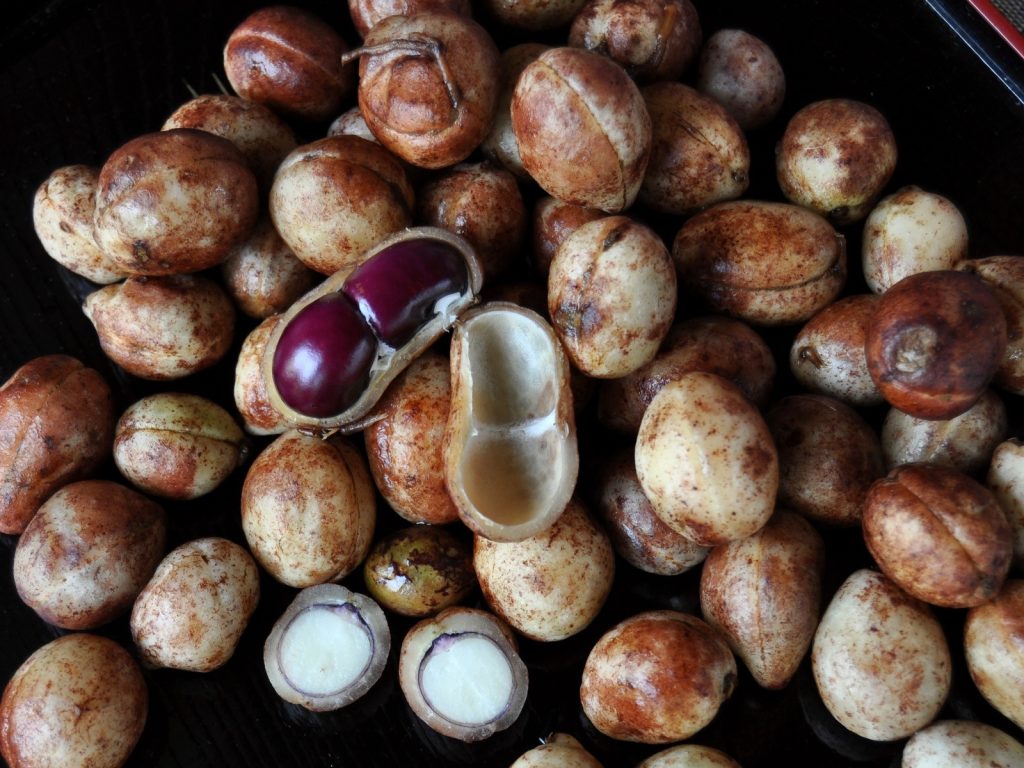
The annual leguminous crop is predominantly self-fertilized with cleistogamous pale-yellow flowers and is grown for its underground seeds. The entire plant and growth habit is like those of the common peanut with both erect forms and the low, flat (or open) forms with compound leaves of three leaflets. Like the peanut, it forms pods and seeds on or mostly just below the soil surface, hence the suffix ‘groundnut’ in the name. To set pods underground, the flower stalk elongates and penetrates the soil as the bulbous tip creates a tunnel through which the fertilized flower, attached just behind the tip, is drawn into the soil. There are numerous nitrogen-fixing nodules on the roots. The pods are round, wrinkled, and over half an inch long. Commonly, each pod contains one or two seeds that vary in morphology and color (smooth, round, oval, and in-between, cream, brown, red, orange, mottled, and black) and are very hard when dried.
5. GROWTH CONDITIONS
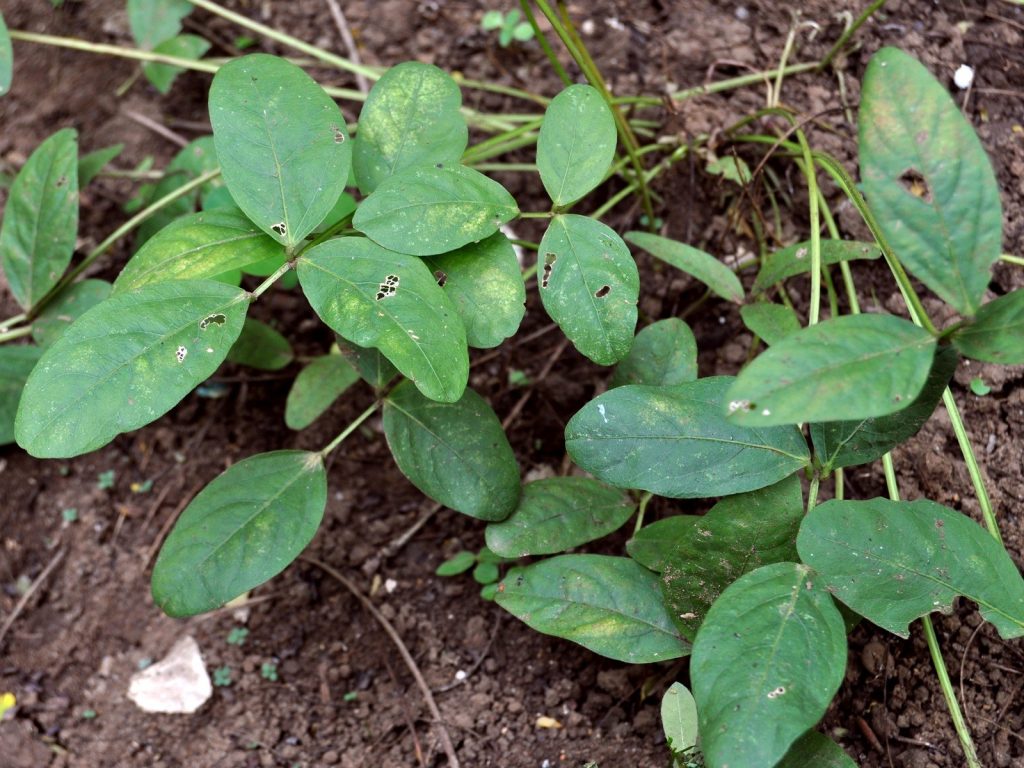
Bambara groundnut grows best in climates suitable for peanuts, which include bright sunshine, elevated temperatures, at least 4 months free of frost (where applicable), and frequent rains. The plant, however, is highly adaptable with much greater tolerance to harsh conditions than most crops. It yields under conditions too dry for peanuts, such as in the Bambara District near Timbuktu on the Sahara Desert’s Southern fringe. It also is known to grow in rainforest areas and the cool, moist highlands of Zimbabwe. When grown like the peanut, Bambara groundnuts mature between 3 to 6 months from planting depending on climatic conditions and the cultivar.
6. PRODUCTION AND USE
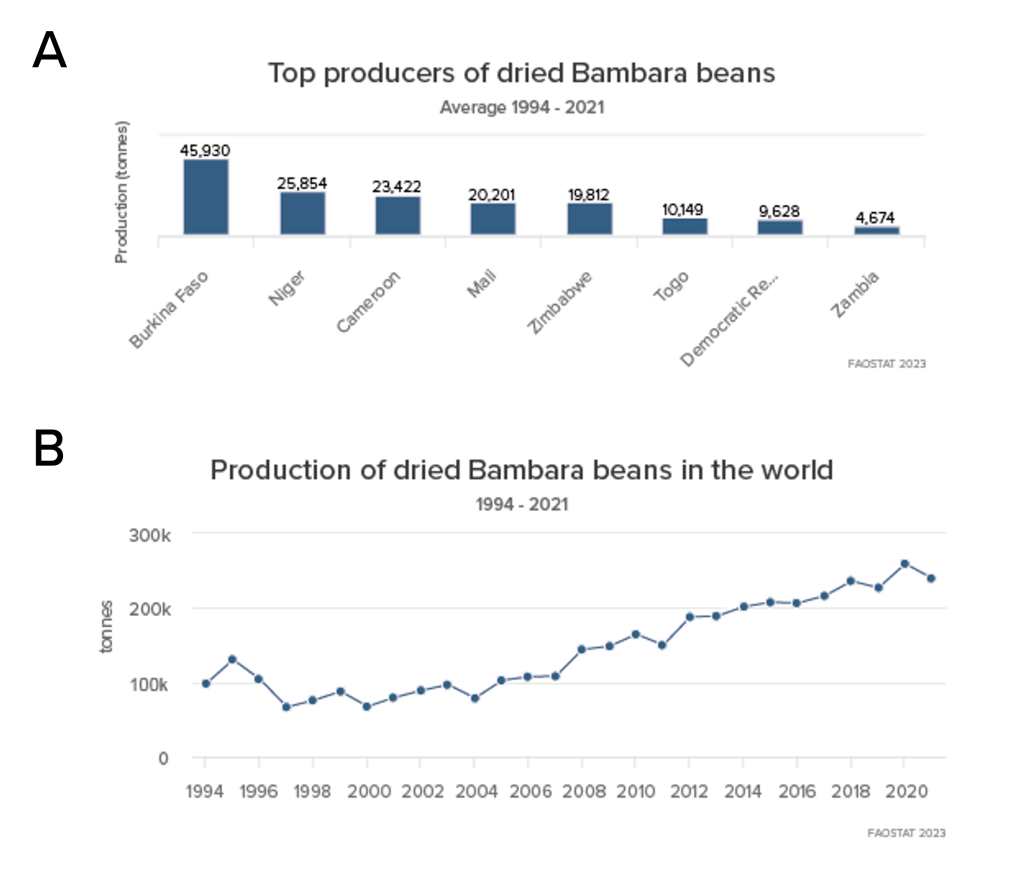
In the past 20 years there has been a slow but steady increase in Bambara groundnut production (FAOSTAT, 2023). Average dry BGN bean production data (1990 to 2021) show that Burkina Faso leads the top ten producers with around 40,000 tonnes (FAOSTAT, 2023).
The seeds may be eaten raw when immature but become too hard when mature, therefore seeds are commonly boiled, roasted, or fried before eating. When roasted or boiled, even the mature seeds are sweet and pleasant tasting. The seeds are often roasted and ground into nutritious flour steamed or fried in oil. Seeds contain 14-24% protein and about 60% carbohydrates (FAOSTAT, 2023). The protein is reported to be higher in the essential amino acid methionine than other grain legumes. Bambara groundnuts contain 6-12% oil, which is less than half the amount found in peanuts, making them not favored as an oilseed crop. The tops (commonly the leaves and stalks) are rich in nitrogen and phosphorus and therefore are used as livestock feed, fodder, and forage (Mubaiwa et al., 2018).
In Africa, Bambara groundnut is often preferred as a dietary supplement to milk from soybean and cowpea (Bamshaiye et al., 2011). It has other health benefits which include a cure for diarrhea (Atoyebi et al., 2018), prevention of high blood pressure (Lin Tan et al., 2020), treatment of wounds and healing epilepsy (FAO et al., 2020), and controlling morning sickness during pregnancy when chewed and swallowed (Jideani & Diedericks, 2014).
7. BREEDING AND IMPROVEMENT
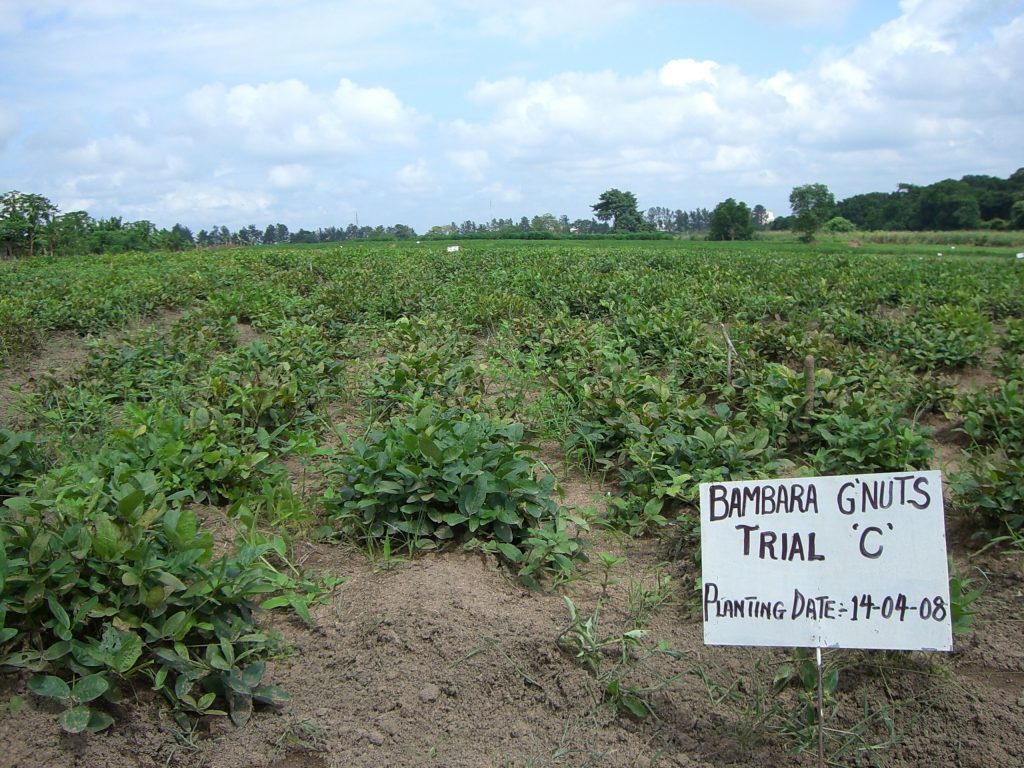
Bambara groundnut is an annual diploid species (2n = 2x = 22), has a complex reproductive system, and is described as recalcitrant to artificial hybridization (Gerrano et al., 2021). The world collection of BGN germplasm is reported to be a little over 6000 accessions from 25 African countries (Muhammad et al., 2020), with the largest number of accessions (2035) being held by the International Institute of Tropical Agriculture (IITA) (Goli, 1997).
Based on the analysis of seeds, Begemann (1988) reported ecogeographic differentiation present in BGN. Characterization and evaluation techniques such as phenotypic descriptors (IPGRI et al., 2000), biochemical markers (Pasquet et al.,1999), molecular markers including amplified fragment length polymorphism (AFLP) markers (Massawe et al., 2002), random amplified polymorphic DNA (RAPD) (Massawe et al., 2003), simple sequence repeat (SSR) markers (Beena et al., 2012; Molosiwa et al., 2013; Aliyu & Massawe, 2013; Redjeki et al., 2020), DArT markers (Olukolu et al., 2012), and single nucleotide polymorphism (SNP) markers (Redjeki et al., 2020) have been used to assess the available germplasm, and all reached the same conclusion of great genetic diversity present.
Even after it being declared one of the “crops of the new millennium” (Ahmad, 2012), little attention from international organizations has been given to the crop. There are currently no breeding programs targeting the development of improved cultivars from segregating families and therefore, to date, there are no registered or improved cultivars of Bambara groundnut. Farmers still use landraces, developed through several generations of mass selection, since most all improvement attempts are limited to the evaluation for yield and yield-related traits of local collections or introduced germplasm. A very early attempt toward improving BGN was by Doku and Karikari (1971) who reported the development of cultivated Bambara groundnut (Voandzeia subterranea var. subterranea) from wild Bambara (V. subterranea var. spontanea) to change from wild characteristics such as: from open to a compact or bunch growth habit, from outbreeding to inbreeding system to reduce or eliminate dependence on ants for pollination, increased stem number, reduction in leaf area, and reduction in shell thickness.
8. UNTAPPED POTENTIAL

Several review articles have documented the important role BGN will play towards global food security (Hillocks et al., 2012; Gregory et al., 2019; Paliwal et al., 2021; Khan et al., 2021; and many more), yet the crop has not received the attention necessary to make the needed advances in the improvement and release of high-yielding biotic and abiotic stress-tolerant varieties to farmers. Breeding that is focused on solutions to the reasons for the crop being underutilized—including poor processing methods; the hard-to-cook phenomenon (3 to 4 hours) (Mubaiwa, 2018); relatively low yields; lack of mechanization related to planting, harvesting, and different post-harvest operations, such as its drying, de-husking, and hard-to-mill properties—can improve the commercial potential of the crop, which is currently low (Ibny et al., 2019). This will make the crop more attractive for production in areas outside the current growing zone, thus expanding its production area. Various science-based research (Esan et al., 2023, among others) have reported significant differences among lines or accessions evaluated, further confirming the variability present, and therefore the potential for improvements, with research-center yields of 3.0 to 4.5 t/ha reported (Pasquet et al., 1999; Azam-Ali et al., 2001).
Through conventional breeding, the application of biotechnology, and recent “omics” technologies (transcriptomics, proteomics, and metabolomics), significant breakthroughs in various crops have been realized in molecular biology, genetics, and elucidation of the molecular mechanism of complex traits which include stress tolerance, yield, flowering, crop maturity, and nutritional value and have led to increased food production. For the past two decades, the application of SNP technology, among other advances, yielded significant impacts on crop improvement and the description of genetic diversity in major crops. However, due to the lack of attention given to BGN by breeders and both national and international funding organizations (Heller et al., 1997; Massawe et al., 2005; Oyeyinka et al., 2015; Paliwal et al., 2021; Will, 2008; Williams & Haq, 2002), these technologies and their potential application for increased food production will remain untapped in BGN. Given the genome sequencing efforts undertaken in BGN (Salazar-Licea et al., 2022), coupled with the inherent attributes of the crop—high nutritional value, tolerance of abiotic stresses, and its potential resilience to climate change—support for this crop should be a high priority in the near future, if not now.
9. REFERENCES
Adzawla W, Donkoh SA, Nyarko G, O’Reilly PJ, Olayide O, Mayes S, Feldman AB, Halimi RA. 2016a. Adoption of Bambara groundnut production and its effects on farmers’ welfare in Northern Ghana. African Journal of Agricultural Research 11:583-594. DOI: 10.5897/AJAR2015.10568
Adzawla W, Donkoh SA, Nyarko G, O’Reilly P, Mayes S. 2016b. Use patterns and perceptions about the attributes of Bambara groundnut (Vigna subterranea (L.) Verdc.) in Northern Ghana. Ghana Journal of Science, Technology & Development 4:56-71. Available from: gjstd.org/index.php/GJSTD/article/view/88
Ahmad NS. 2012. Bambara Groundnut, the Crop for the New Millennium: Molecular Techniques to Improve the Resiliency of Bambara Groundnut. Lambert Academic Publishing, Sunnyvale, CA.
Aliyu S, Massawe FJ. 2013. Microsatellites based marker molecular analysis of Ghanaian Bambara groundnut (Vigna subterranean (L.) Verdc.) landraces alongside morphological characterization. Genetic Resources and Crop Evolution 60:777-787. DOI: 10.1007/s10722-012-9874-y
Atoyebi JO, Osilesi O, Abberton M, Adebawo O, Oyatomi O. 2018. Quantification of selected anti-nutrients and bioactive compounds in African Bambara groundnut [Vigna subterranea (L.) Verdc.]. American Journal of Food and Nutrition 6:88-95. Available from: pubs.sciepub.com/ajfn/6/3/5
Azam-Ali SN, Sesay A, Karikari SK, Massawe F, Aguilar-Manjarrez J, Bannayan M, Hampson KJ. 2001. Assessing the potential of an underutilized crop–A case study using Bambara groundnut. Experimental Agriculture 37:433-472. DOI: 10.1017/S0014479701000412
Bamshaiye OM, Adegbola JA, Bamishaiye EI. 2011. Bambara groundnut: an underutilized nut in Africa. Advances in Agricultural Biotechnology 1:60-72.
Beena R, Sheshshayee MS, Madhura JN, Prasad TG, Udayakumar M. 2012. Development of SSR Markers and Genetic Variability in Physiological Traits in Bambara Groundnut (Vigna subterranea L. Verdc). In: Sabu A, Augustine A. (Eds.) Prospects in Bioscience: Addressing the Issues. Springer, India. pp. 229-242. DOI: 10.1007/978-81-322-0810-5_27
Begemann F. 1988. Ecogeographic differentiation of Bambara groundnut (Vigna subterranea) in the collection of the international institute of tropical agriculture (IITA). Ph.D. thesis, Technical University of Munich, Germany.
Dalziel JM. 1937. Voandzeia Thou. In: The Useful Plants of West Tropical Africa. Crown Agents, London, pp. 269-271.
Doku EV, Karikari SK. 1971. Operational selection in wild Bambara groundnut. Ghana Journal of Science 11:45-56.
Esan VI, Oke GO, Ogunbode TO. 2023. Genetic variation and characterization of Bambara groundnut [Vigna subterranea (L.) verdc.] accessions under multi-environments considering yield and yield components performance. Scientific Reports 13:1498. DOI: 10.1038/s41598-023-28794-8
FAO, IFAD, UNICEF, WFP, WHO. 2020. The State of Food Security and Nutrition in the World 2020. Transforming food systems for affordable healthy diets. FAO, Rome. DOI: 10.4060/ca9692en
FAOSTAT. 2023. Statistical Database. Food and Agriculture Organization of the United Nations. Accessed 15 March, 2023. Available from: fao.org/faostat/
Gerrano AS, Eifediyi EK, Labuschagne M, Ogedegbe FO, Hassen AI. 2021. Production Practices of Bambara Groundnut. In: Oyeyinka SA, Ade-Omowaye BIO (Eds.) Food and Potential Industrial Applications of Bambara Groundnut. Springer, Cham. pp. 7-25. DOI: 10.1007/978-3-030-73920-1_2
Goli AE. 1997. Bibliographical Review. In: Heller J, Begemann F, Mushonga J (Eds.) Proceedings of the workshop on Conservation and Improvement of Bambara Groundnut (Vigna subterranean [L.] Verdc.), 14–16 Nov 1995, Harare, Zimbabwe, International Plant Genetic Resources Institute, Rome. pp. 4-10. Available from: hdl.handle.net/10568/104199
Gregory PJ, Mayes S, Hui CH, et al. 2019. Crops for the future (CFF): an overview of research efforts in the adoption of underutilised species. Planta 250:979-988. DOI: 10.1007/s00425-019-03179-2
Heller J, Begemann F, Mushonga J. 1997. Proceedings of the workshop on Conservation and Improvement of Bambara Groundnut (Vigna subterranean [L.] Verdc.), 14–16 Nov 1995, Harare, Zimbabwe, International Plant Genetic Resources Institute, Rome. pp. 4-10. Available from: hdl.handle.net/10568/104199
Hepper FN. 1963. The Bambara groundnut (Voandzeia subterranea) in West Africa. Kew Bulletin 16:398-407.
Hepper FN. 1970. Bambara groundnut (Voandzeia subterranea). Field Crop Abstracts 23:1-6.
Hillocks RJ, Bennett C, Mponda OM. 2012. Bambara nut: a review of utilisation, market potential and crop improvement. African Crop Science Journal 20:1-16. Available from: ajol.info/index.php/acsj/article/view/78601
Holm JM, Marloth BW. 1940. Bambarra groundnut or Njugo bean. Farming in South Africa 15:195-198.
Ibny FY, Jaiswal SK, Mohammed M, Dakora FD. 2019. Symbiotic effectiveness and ecologically adaptive traits of native rhizobial symbionts of Bambara groundnut [Vigna subterranea (L.) Verdc.] in Africa and their relationship with phylogeny. Scientific Reports 9: 12666. DOI: 10.1038/s41598-019-48944-1
IPGRI (International Plant Genetic Resources Institute), IITA (International Institute of Tropical), BAMNET (International Bambara Groundnut Network). 2000. Descriptors for Bambara groundnut (Vigna subterranea). International Plant Genetic Resources Institute 48 p. Available from: hdl.handle.net/10568/72704
Jideani VA, Diedericks CF. 2014. Nutritional, Therapeutic, and Prophylactic Properties of Vigna subterranea and Moringa oleifera. In: Oguntibeju (Ed.) Antioxidant-Antidiabetic Agents and Human Health. InTech, London. pp. 187-207. DOI: 10.5772/57338
Khan MMH, Rafii MY, Ramlee SI, Jusoh M, Al-Mamun M. 2021. Bambara groundnut (Vigna subterranea L. Verdc): A crop for the new millennium, its genetic diversity, and improvements to mitigate future food and nutritional challenges. Sustainability 13:5530. DOI: 10.3390/su13105530
Lin Tan X, Azam-Ali S, Goh EV, Mustafa MA, Chai HH, Kuan Ho W, Mayes S, Mabhaudhi T, Azam-Ali S, Massawe F. 2020. Bambara groundnut: An underutilized leguminous crop for global food security and nutrition. Frontiers in Nutrition 7:276. DOI: 10.3389/fnut.2020.601496
Massawe F, Dickinson M, Roberts JA, Azam-Ali SN. 2002. Genetic diversity in Bambara groundnut (Vigna subterranea (L.) Verdc) landraces revealed by AFLP markers. Genome 45:1175-1180. DOI: 10.1139/g02-093
Massawe F, Mwale S, Azam-Ali S, Roberts J. 2005. Breeding in Bambara groundnut (Vigna subterranea (L.) Verdc.): Strategic considerations. African Journal of Biotechnology 4:463-471. Available from: ajol.info/index.php/ajb/article/view/15123
Massawe F, Schenkel W, Basu S, Temba EM. 2003b. Artificial hybridization in Bambara groundnut (Vigna subterranea (L.) Verdc.). Proceedings of the International Bambara Groundnut Symposium 1:193-209. Available from: researchgate.net/publication/288345277
Molosiwa O, Basu SM, Stadler F, Azam-Ali S, Mayes S. 2013. Assessment of genetic variability of Bambara groundnut (Vigna subterranean (L.) Verde.) accessions using morphological traits and molecular markers. Acta Horticulturae 979:779-790. DOI: 10.17660/ActaHortic.2013.979.87
Mubaiwa J. 2018. Managing the hard-to-cook (HTC) phenomenon in Bambara groundnut (Vigna subterranea (L.) Verdc.) processing for resource limited communities in Zimbabwe. Ph.D. Thesis, Wageningen University, The Netherlands.
Mubaiwa J, Fogliano V, Chidewe, C, Bakker EJ, Linnemann AR. 2018. Utilization of Bambara groundnut (Vigna subterranea (L.) Verdc.) for sustainable food and nutrition security in semi-arid regions of Zimbabwe. PLoS ONE 13:e0204817 DOI: 10.1371/journal.pone.0204817
Muhammad I, Rafii MY, Ramlee SI, et al. 2020. Exploration of Bambara groundnut (Vigna subterranea (L.) Verdc.), an underutilized crop, to aid global food security: varietal improvement, genetic diversity and processing. Agronomy 10:766. DOI: 10.3390/agronomy10060766
Murevanhema YY, Jideani VA. 2013. Potential of Bambara groundnut (Vigna subterranea (L.) Verdc) milk as a probiotic beverage—A review. Critical Reviews in Food Science and Nutrition 53:954-967. DOI: 10.1080/10408398.2011.574803
Ntundu WH, Shillah SA, Marandu WYF, Christiansen JL. 2006. Morphological diversity of Bambara groundnut [Vigna subterranea (L.) Verdc.] landraces in Tanzania. Genetic Resources and Crop Evolution 53:367-378. DOI: 10.1007/s10722-004-0580-2
Olayide OE, Donkoh SA, Ansah IGK, et al. 2018. Assessing socioeconomic factors influencing production and commercialization of Bambara groundnut as an indigenous climate resilient crop in Nigeria. In: Filho WL (Ed.) Handbook of climate change resilience. Springer, Cham. pp. 1-19. DOI: 10.1007/978-3-319-71025-9_158-1
Olukolu BA, Mayes S, Stadler F, et.al. 2012. Genetic diversity in Bambara groundnut (Vigna subterranea (L.) Verdc.) as revealed by phenotypic descriptors and DArT marker analysis. Genetic Resources and Crop Evolution 59:347-358. DOI: 10.1007/s10722-011-9686-5
Oyeyinka SA, Singh A, Odebola PO, Gerrano AS, Amonsou EO. 2015. Physicochemical properties of starches with variable amylose contents extracted from Bambara groundnut genotypes. Carbohydrate Polymers 133:171-178. DOI: 10.1016/j.carbpol.2015.06.100
Paliwal R, Adegboyega TT, Abberton M, Faloye B, Oyatomi O. 2021. Potential of genomics for the improvement of underutilized legumes in sub-Saharan Africa. Legume Science 3:1-16. DOI: 10.1002/leg3.69
Panzeri D, Guidi Nissim W, Labra M, Grassi F. 2022. Revisiting the domestication process of African Vigna species (Fabaceae): Background, perspectives and challenges. Plants 11:532. DOI: 10.3390/plants11040532
Pasipanodya JT, Horn LN, Achigan-Dako EG, Musango R, Sibiya J. 2022. Utilization of plant genetic resources of Bambara groundnut conserved ex situ and genetic diversification of its primary genepool for semi-arid production. Agriculture 12:492. DOI: 10.3390/agriculture12040492
Pasquet RS, Schwedes S, Gepts P. 1999. Isozyme diversity in Bambara Groundnut. Crop Science 39:1228-1236. DOI: 10.2135/cropsci1999.0011183X003900040045x
Redjeki ES, Ho WK, Shah N, Molosiwa NR, Ardiarini K, Mayes S. 2020. Understanding the genetic relationships between Indonesian Bambara groundnut landraces and investigating their origins. Genome 63:319-327. DOI: 10.1139/gen-2019-0137
Rungnoi O, Suwanprasert J, Somta P, Srinives P. 2012. Molecular genetic diversity of Bambara groundnut (Vigna subterranea L. Verdc.) revealed by RAPD and ISSR marker analysis. SABRAO Journal of Breeding & Genetics 44:87-101.
Salazar-Licea L, Mateva KI, Gao X, Halimi RA, et al. 2022. The Bambara Groundnut Genome. In: Chapman MA (Ed.) Underutilised Crop Genomes. Compendium of Plant Genomes. Springer, Cham. pp. 189-215. DOI: 10.1007/978-3-031-00848-1_11
Verdcourt B. 1980. The correct name for Bambara groundnut. Kew Bulletin 35:474.
Will M. 2008. Promoting value chain of neglected and underutilized species for pro-poor growth and biodiversity conservation. Guidelines and Good Practices. Global Facilitation Unit for Underutilized Species, Rome. Available from: Bioversity International NUS Community
Williams JT, Haq N. 2002. Global research on underutilized crops: An assessment of current activities and proposal for enhanced cooperation. Bioversity International, Rome. Available from: Alliance Biodiversity & CIAT
10. CHAPTER INFORMATION
Chapter citation: Mahama AA. 2023. Bambara Groundnut (Vigna subterranea). In: Chen K, Byrne P (Eds.) Understudied Indigenous Crops. Fort Collins, Colorado: Colorado State University. Date accessed. Available from https://colostate.pressbooks.pub/understudiedindigenouscrops/chapter/bambara-groundnut/
Chapter editors: Katheryn Chen and Patrick Byrne

